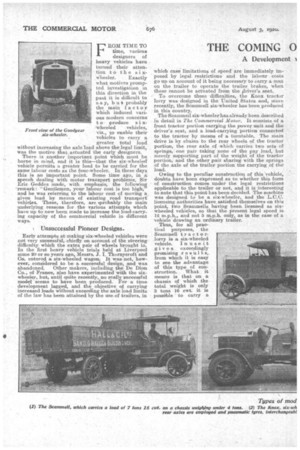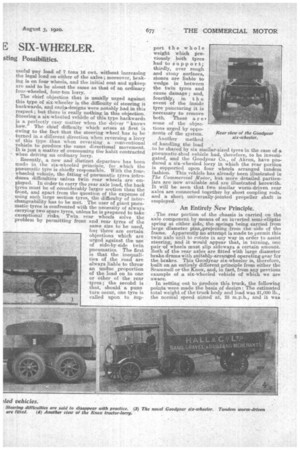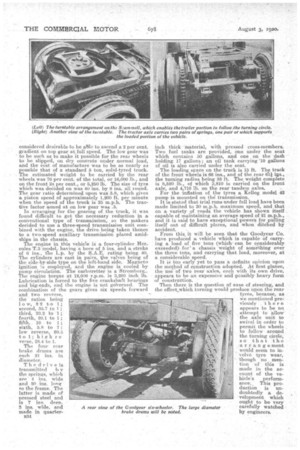THE COMING 0 E SIX-WHEELER.
Page 10

Page 11

Page 12

If you've noticed an error in this article please click here to report it so we can fix it.
A Development sting Possibilities.
Front new of the Goodyear six -wheeler.
FROM TIME TO time, various designers of heavy vehicles have turned their attention to the sixwheeler. Exactly what motives prompted investigation in this direction in the past it is difficult to a a y, b u t probably the main factor which induced various modern concerns toproduce six
wheeled vehicles, viz., to enable their vehicles to carry a greater total load without increasing the axle lead above the legal limit, was the motive that actuated the early designers.
There is another important point which must be borne in mind, and it is this—that the six-wheeled vehicle permits a greater load to be carried for the same labour costs as the four-wheeler. In these days this is an important point. Some time ago, in a speech dealing with motor transport problems, Sir Eric Geddes made, with emphasis; the following remark: "Gentlemen, your labour cost is too high," and he was referring to the labour cost of moving a given load by means of existing road transport vehicles. These, therefore, are probably the main underlying reasons for the various attempts which have up to now been made to increase the load-carrying capacity of the commercial vehicle in different Israys;
Unsuccessful Pioneer Designs.
Early attempts at making six-wheeled vehicles were not very successful, chiefly on account of the steering difficulty which the extra pair of wheels brought in. In the first heavy vehicle trials held at Liverpool some 20 or so years ago, Messrs. J. I. Thornycroft and Co. entered a six-wheeled wagon. It was not, however, considered to he a successful design, and was abandoned. Other makers, including the De Dion Co., of France, also have experimented with the sixwheeler, but, until quite recently, no really successful naodel seems to have been produced. For a time development lagged, and the obiective of carrying increased loads without exceeding the axle load limits of the law has been attained by the use of trailers, in
which case limitations of speed. are immediately imposed by legal restrictions and the labohr costs gor up on account of it being necessary to carry a man on the trailer to operate the trailer brakes, when these cannot be actnated from the driver's seat.
To overcome these .difficulties, the Knox tractor lorry was designed in the 'United States and, more recently, the Scaminefl six-wheeler has been produced in this country.
The 5-eammed six-wheeler has already been described in detail in Tim Commercial Motor. It consists of a front tractor portion carrying the power unit and the driver's seat, and a load-carryingportion connected to the tractor by means of a turntable. The Main drive is by chains to the rear wheels of the tractor portion, the rear axle of which tarries two sets of springs, one pair taking none of the pay load, but merely supporting part of the weight. of the tractor portion, and the other pair sharing with the springs of the axle of the trailer portion the carrying ,of the load.
Owing to the peculiar construction of this 'vehicle, doubts have been expressed is to whether this form of construction comes under the legal restrictions applicable to the trailer or not, and it is interesting to note that this point has been decided. The machine was designed to be a six-wheeler, and the L.C.C. licensing authorities have satisfied themselves on this point, two .Searnmells having been. licensed as sixwheeled vehicles, so that the Present legal speed is 12 m.p.h., and not 5 m.p.h. only., as in the case of a. 'vehicle 'drawing an ordinary trailer.
Thus, for all practical purposes, the Seammell tractor lorry is a six-wheeled vehicle. In nse it give a exceedingly promising o iil t s, from which it is easy to see the advantage of this type of construction. What it means is that on a chassis of which the total weight is only 3 tons 16 cwt. it is possible to carry a useful pay load of 7 tons 16 cwt. without increasing the legal load on either of the axles ; moreover, braking is on four wheels, and the initial cost and upkeep are said to be about the same as that of an ordinary four-wheeled, four-ton lorry.
The chief objection that is usually urged against this type of six-wheeler is the difficulty of steering it backwards, and earlysdesigns were notably bad in this respect ; but there is really nothing in this objection. Steering a six-wheeled vehicle of this type backwards is a perfectly easy matter when the driver "knows how." The chief difficulty which arises at first is owing to the fact that the steering wheel has to be turned in a different direction when reversing a lorry of this type than when reversing a conventional vehicle to produce the same directional movement. It is just a matter of overcoming the habit contracted when driving an ordinary lorry.
Recently, a new and distinct departure has been
made in. the six-wheeled principle, for which the pneumatte tyre is chiefly responsible. With the four7
wheeled vehicle, the fitting of pneumatic tyres intro duces difficulties unless twin rear wheels are em ployed_ In Order to carry the rear axle load, the back tyres must be of considerably larger section than the front, and apart from the question of the expense of using such large section tyres, the difficulty of inter changeability has to be met. The user of giant pneu matic tyres is confronted with the necessity of always carrying two spare tyres, unless he is prepared to take ,exceptional risks. Twin rear wheels solve the
problem by permitting front and rear tyres of the same size to be used, but there are certain objections which are urged against the use of side-by-side twin pneumatics. The first is that the inequalities of the road are .always liable to throw an undue proportion of the load on to one or other of the rear .tyres; the second is that, should a pane ture occur, one tyre is called upon to . Sup
port the whole weight which Previously both tyres had to support; thirdly, over rough and stony surfaces, stones are liable to wedge in between the twin tyres and cause damage ; and, fourthly, in t h event Of the inside tyre puncturing it is necessary to remove both. These ar ew some of the objections urged by opponents of the system.
An other method of handling the load . to he shared by six similar-sized tyres in the case of a pneumatic-shod vehicle had, therefore, to be investi gated, and the Goodyear Co, of Akron, have pro duced a six-wheeled lorry in which the rear portion is supported upon four wheels arranged tandem fashion. This vehicle has already been illustrated in
The Commercial Motor, but more detailed particulars are now available and are illustrated herewith.
It will be seen that two similar worm-driven rear axles are connected together by short coupling rods, and a short universally-jointed propeller shaft is employed.
An Entirely Slew Principle.
The rear portion of the chassis is carried on the axle component by means of an inverted semi-elliptic spring at either side, the springs being carried from large diameter pinseprojectang from the side of the frame. Apparently no attempt is made to permit this twin axle unit to rotate in any way in order to assist steering, and it would appear that, in turning, one pair of wheels must slip sideways a certain amount. Both of the rear axles are fitted with large diameter brake drums with suitably-arranged operating gear for the brakes. This Goodyear six-wheeler is, therefore, built on an entirely different principle from either the Scammell or the Knox, and, in fact, from any previous example of a six-wheeled vehicle of which we are aware.
In setting out to Produce this truck, the following points were made the basis of design: The estimated total weight of the truck body and load was 21,000 lb., the normal speed aimed at, 25 m.p.h., and it was
considered desirable-to be alKe to ascend A 2 per cent. gradient on top gear at full speed. , The low gear was to be such as to make it possible for the rear wheels to be slipped, on dry concrete under normal load, and the cost of manufacture was to be as nearly as possible that of a standard 5 ton, solid-tyred truck. The estimated weight to be carried by the rear wheels was 76 per cent, of the total, or 16,000 lb., and on the front 24 per cent., or 5,260 lb. The size of tyre which was decided on was 40 ins, by 8 ins, all round. The gear ratio determined upon wag,5.8, which gives .a piston speed of approximately 1,200 ft. per minute when the speed of the truck is 25 'm.p.h. The tractive factor aimed at on low gear was .5.
In arranging for the gearing of the truck, it was found difficult to get the necessary reduction in a conventional type of transmission, so the makers decided to use a three-speed transmission unit combined with the engine, the drive being taken thence to a two-speed auxiliary transmission placed amidships in the chassis.
The four rear brake drums are each 21 ins, in din meter.
The drive is
transmitted ib the springs, which are 4 ins, wide and 50 . ins, long to the frame. The latter is made of pressed steel and is 7 ins. deep. n ins. wide, and made in quarter
1334
inch thick 'material, with pressed cross-members. Two fuel tanks are provided, one under the seat which contains 50 gallons, and one on. the -dash holding 17 gallons ; an oil tank carrying '10 gallons of oil is also carried under the seat.
The loading space on the truek is 15 ft. The track of the front wheels is 66 ins., and of the rear 61+ ips., the turning radius being 35 ft. The weight complete is 8,520 lb., of which 3,810 is carried on the front axle, and 4,710 lb. on the rear tandem axles. For the inflation of the tyres a Kellog model 42 pump is mounted on th4 transmission. It is stated that trial rung under full load have been made limited to 30 ni.P.h. maximum speed, and that on a variety of roads the vehicle has shown itself capable of maintaining an average speed of 21 m.p.h., and it is ,said to have exceptional powers for [pulling itself out of difficult places, and when ditched by accident. •
From this it will be seen that the Goodyear Co. have produced a vehicle which is capable of carrying a load of five tons (whichcan be cansiderably exceeded), fort a chassis weight of something over the three tons, and carrying that load, moreover, at a considerable speed. It is toe early yet to pass a definite oninion upon the method of construction adopted. At first glance, the usd. of two rear axles, each with its, own drive, appears to be an expensive and possibly lnavy form of constrnotion.
Then there is the question of ease of steering, and the effeck,which turning would produce upon the rear tyres, because, as we mentioned previously there appears to be no attempt to allow the axle unit to swivel in order to permit the wheels to follow around the turning circle, so that the -a r r angeraent would seem to involve tyre wear, though no mention of this is made in the account of the vehicle's performance., This production is undoubtedly a development which ought to be very carefully watched by engineers.






























